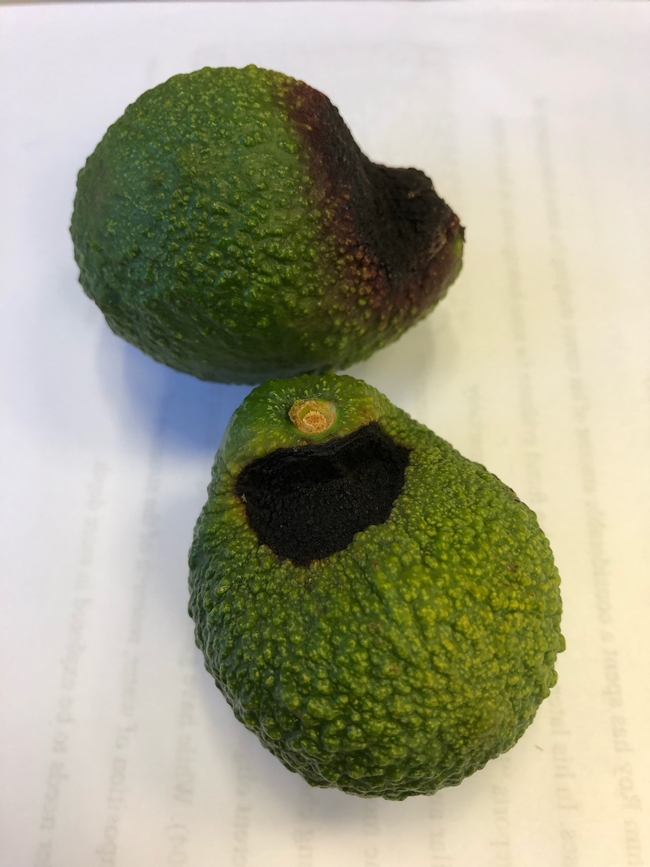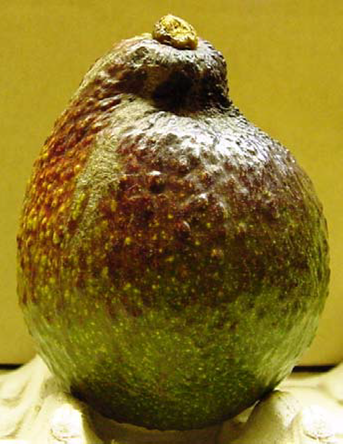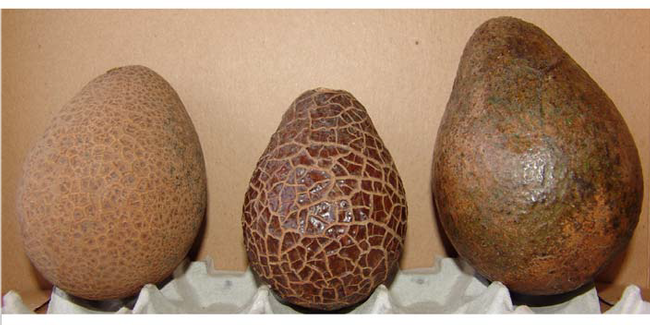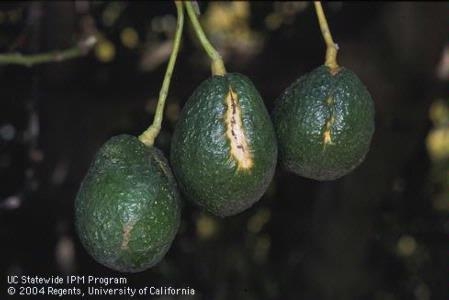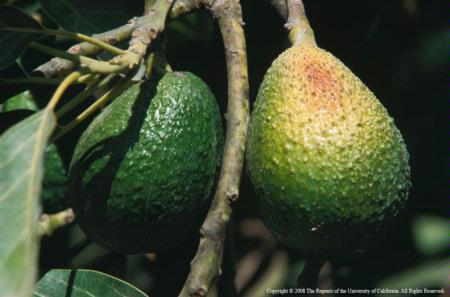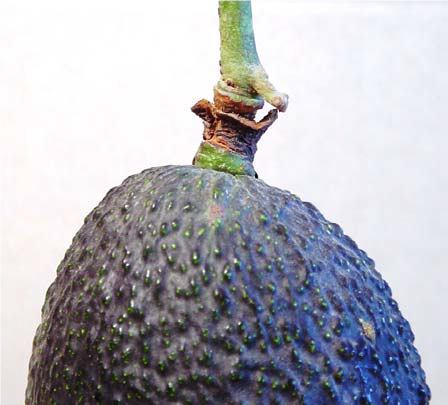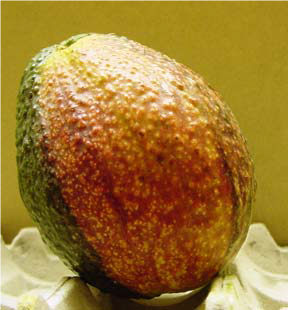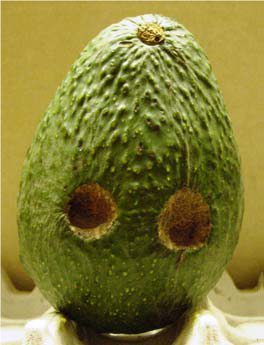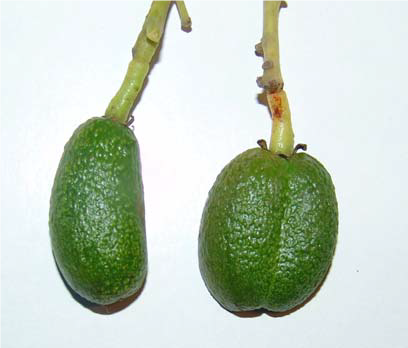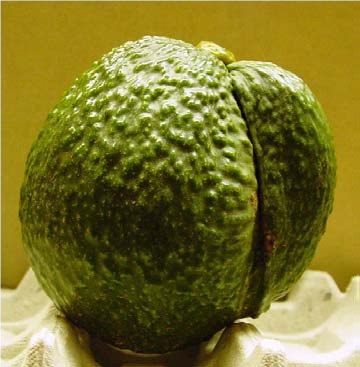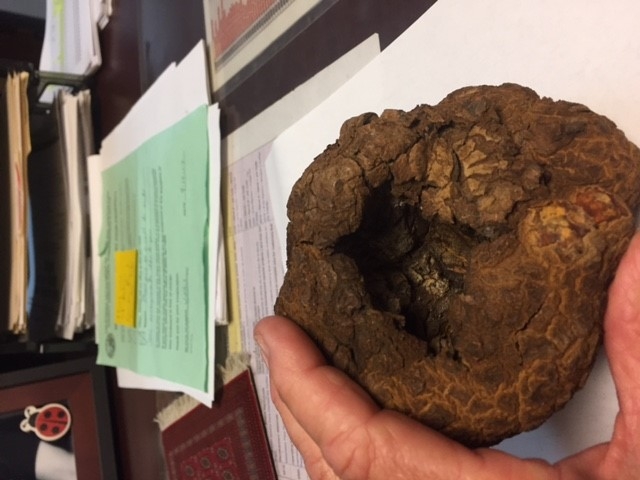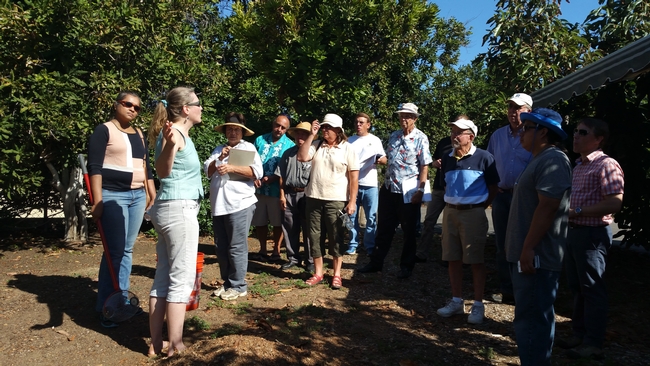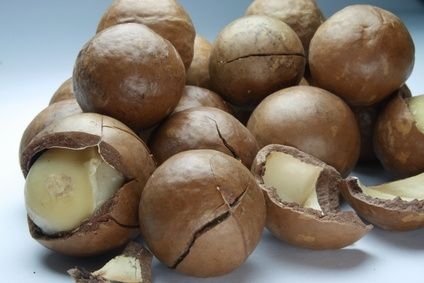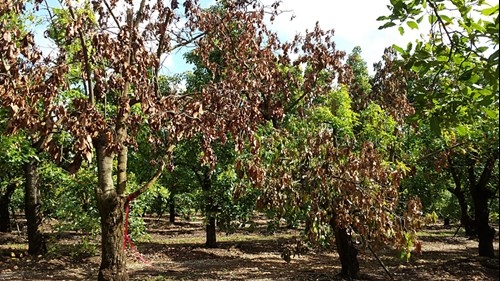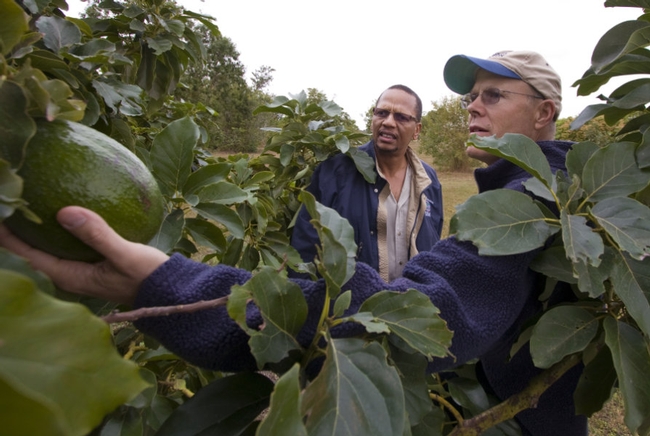
Posts Tagged: California
These things pop up in the avocado orchard
Boom, just when you think everything is going fine, you run across a reminder that there are little things going on in the orchard that are out of our control. In Goleta, I just ran across these crick-side, crook neck fruit that are a reminder that we just had about 3 weeks of foggy weather (in the fall, when it's supposed to be in the spring) and then a week of hot weather which is just the condition to create this calcium imbalance and distorted fruit. It's no big big deal, unless it was all over tree. Just more of an oddity. Harvest time is past this year so didnt expect to see it on this new fruit.
At avocado harvest time, growers are in the orchard checking things out a little more closely and to see what is going into the bins…..and they see some unusual shaped fruit. Here's what's been popping up and some possible explanations.
Crick-side - First described by Dr. J. Eliot Coit as kink-neck and later by Horne (1931) as kink-side. Finally, the name crick-side (Horne, 1934) was adopted. It is characterized by a definite depression on one side between the stem end and the larger portion of the fruit causing a distortion. In some cases, the area of depression turns black and the fruit drops. In other cases, the fruit grows and matures but the distortion remains. Crick-side is usually found on trees carrying a heavy load of fruit. It has been suggested that high temperatures or temporary water-stress may relate to the occurrence of crick-side, but no definite determination as to its cause has been made.
Carapace Spot - First described by Horne (1929), the name carapace-spot was chosen because of the resemblance to a turtles' back. This external blemish is corky and usually cracked into somewhat regular, angular divisions. The flesh under the carapace spot is undamaged, but exterior appearance is such that the fruit is reduced in grade. Slight rubbing or brushing of tender young fruit on leaves or stems appears to cause this corky growth to start. Fruit on trees exposed to strong winds are more apt to develop the trouble. Windbreaks should reduce injury in windy areas.
Photo: Avocado thrips damage, carapace damage and greenhouse thrips damage.
Sunblotch - This is a viroid that can affect fruit, leaves, and stems with a yellow or reddish streaking, cause a compacted growth and willowy growth habit. The streaking in the fruit is usually depressed and doesn't extend the length of the body.
Sunburn - Fruit exposed to full sun may be injured by sunburn. This occurs when trees defoliate, or partially defoliate, from any of several causes, leaving the fruit exposed. It is normally most severe on fruit on the south and southwest portion of the tree. Sunburn shows as a pale yellowish area on the exposed side of the fruit. Often the center of this area turns brown to black and may wither.
Ring Neck - This trouble has been observed occasionally, particularly with Hass. The cause is unknown but is believed to be related to soil-plant water deficiency at a critical time. A ring of tissue on the pedicel just above the attachment to the fruit dies, turns black and peels off. If only superficial, the fruit remains on the tree. Growth may be retarded because the restriction impedes movement of nutrients and water outward to the fruit. Most severe in humid coastal areas.
Embossment - Occasionally, and particularly on Fuertes, a section of the surface will be raised slightly or be a darker or lighter color. This is referred to as a sectional chimera or genetic mutation.
Healed over damage - if fruit has mild damage that allows it to heal over (remember avocado fruit expand by cell multiplication not enlargement), then a scar is left, such as this likely amorbia feeding
Cuke - As in cucumber but not a squash. These are seedless fruit that can most often be seen from a fruit set in cooler weather or due to some hormonal stimulus. We don't know the reason, but seems to occur more commonly along the coast.
Double Fruit - In some instances there may be a normal shaped fruit with a single cuke attached ot in some cases there is a double ovary and two fruit are attached.
Woody Avocados - For some unknown reason, avocado fruit will form into a grotesque woody structure hardly resembling an avocado. The cause is genetic and non-transmissible.
Sources: R.G. Platt - California Avocado Society Yearbook 1972-73 and Reuben Hofshi and M.L. Arpaia Yearbook 2002.
Florida Orange Production UP!!!
The USDA has summarized the US citrus crop for 2018-19 and it is up for both California and Florida, with CA accounting for 51% of US production! But the Florida orange crop is up from last year. This is the state that is getting hammered by huanglongbing amongst all the other demands being made on that industry. This is good news for citrus.
The full report is Here
But the summary is:
Citrus utilized production for the 2018-19 season totaled 7.94 million tons, up 31 percent from the 2017-18 season. California accounted for 51 percent of total United States citrus production; Florida totaled 44 percent, and Texas and Arizona produced the remaining 5 percent.
Florida's orange production, at 71.8 million boxes, is up 59 percent from the previous season.Grapefruit utilization in Florida, at 4.51 million boxes, is up 16 percent from last season's utilization. Florida's total citrus utilization increased 56 percent from the previous season. Bearing citrus acreage, at 387,100 acres, is 13,800 acres below the 2017-18 season.
Utilized citrus production in California increased 15 percent from the 2017-18 season. California's all orange production, at 49.8 million boxes, is 13 percent higher than the previous season. Grapefruit production is down 16 percent from the 2017-18 season but tangerine and mandarin production is up 35 percent. Utilized production of citrus in Texas is up 29 percent from the 2017-18 season. Orange production is up 33 percent from the previous season and grapefruit production increased 27 percent. Total citrus production in Arizona's lemon production is up 35 percent from last season.
The value of the 2018-19 United States citrus crop increased 1 percent from last season, to $3.35 billion (packing house-door equivalent). Orange value of production decreased 7 percent from last season and grapefruit value is down 1 percent.
Tangerine and mandarin value of production is 31 percent higher than last season but lemon value of production is down 4 percent.
Overall comparisons discussed above are based on similar fruit types. The revised production and utilization estimates are based on all data available at the end of the marketing season, including information from marketing orders, shipments, and processor records. Allowances are made for recorded local utilization and home use. Estimates for the 2018-19 California Valencia oranges and grapefruit are preliminary.
BUT, the latest news from the Central Valley navel forecast is that it is down,
The 2019-20 California navel crop is down 7% from last season, according to the first U.S. Department of Agriculture estimate.
With harvest expected to begin in October, the California navel forecast is 76 million (40-pound) cartons, down 7% percent from the previous year, the USDA said Sept. 12.
Farming is a roller coaster.

citrus cornucopia
Organic Blueberries Make More Money
Synopsis of: “The Organic Premium for California Blueberries” by Hoy Carmen, professor emeritus in the Agricultural and Resource Economics Dept., UC Davis
Commercial-scale production of blueberries in California is a relatively recent development. California first reported blueberry statistics in 2005 when there were 1,800 acres of blueberries harvested and production of 9.1 million pounds with a total value of $40.58 million. Harvested acres increased to 3,900 acres in 2010 with production of 28 million pounds and a total value of $75.98 million. Growth continued through 2015 with California Agricultural Statistics Survey (CASS) reporting 5,700 acres of blueberries harvested, production of 62.4 million pounds, and total value of $116.98 million.
California blueberries are shipped throughout the U.S. and to a number of export destinations. During the 2016 harvest, California's largest U.S. market was California, which accounted for 34.75% of California's total fresh blueberry shipments of 46,493,407 pounds.
The largest out-of-state domestic shipments were to Texas, Oregon, Washington, Arizona, New York, Minnesota, Utah, and Pennsylvania. These states collectively accounted for 36.54% of California shipments. Canadian shipments of 5.54 million pounds accounted for 11.9% of California's volume and made up 67.1% of exports.
Typically, the price per pound of organically grown blueberries is higher than for conventional production. Prices also vary by package size, with smaller package sizes usually selling for more per pound than larger packages. There is usually a premium for the first portion of the crop-marketing year, and the overall level of prices will vary by year. Prices can also be expected to vary by geographic location. California organic blueberries are among the first domestic fruit on the market when prices tend to be seasonally high.
Growth in California organic blueberry production has outpaced conventional production for several years, and California accounted for about half of the U.S. supply of organic blueberries in 2014. The organic share of California blueberry shipments in 2016 was 23.1% in terms of volume and 34.8% in terms of value. The larger share of value is due to the premium price for organic blueberries.
The organic premium, which averaged $2.28 per pound in both 2015 and 2016 (78–79% of the conventional fresh blueberry price), varies by package and over time. California has some of the earliest domestic blueberry production, with relatively high prices for both conventional and organic blueberries at the beginning of the season. The proportion of shipments that are organic decreases as the season progresses and the organic premium tends to be highest after the first one-third of the season. The growth of organic blueberry production in California, relative to overall California production as well as U.S. organic blueberry production, seems to indicate a comparative advantage for organic blueberries in California. Further growth of organic as well as total blueberry production in California is expected.
For the full article see:
Organic production costs, South Coast
Conventional costs, South Coast
Conventional, San Joaquin Valley
Report on US Organic Sales, 2016
https://www.nass.usda.gov/Newsroom/2017/09_20_2017.php
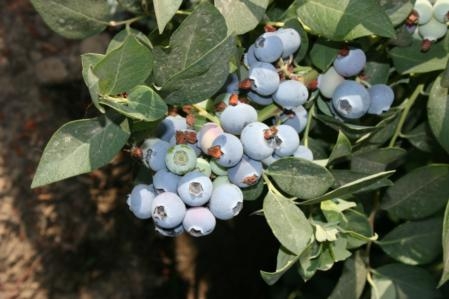
Blueberry fruit
California Macadamia Society Annual Field Day - Saturday, September 30, 2017
The University of California Cooperative Extension in conjunction with the California Macadamia Society and the Gold Crown Macadamia Association will hold their Annual Field Day on Saturday 30 September 2017, 8:45 A.M. to 1:30 P.M. at the home of Thomas & Bobbi Rastle's, 1115 Valencia Drive, Escondido, California.
We will have classes on topics germane to the macadamia industry, with plenty of opportunities for you to ask questions, both general in nature and about the specifics of your operations. We will also be serving a continental breakfast and a delicious lunch. Please plan to join us for a fun and information filled day.
Directions:
From I-5 & I-15, Exit on 78 east, Right on Broadway in Escondido, Left on Washington Ave, Right on Ash Street (it will become San Pasqual Valley Road), Right on Summit Drive, Right on Valencia Drive to 1115.
From I-15 north, Exit Via Rancho Parkway east (it becomes Bear Valley Parkway), Right on San Pasqual Valley Road, (Note: it is about four miles to San Pasqual Valley Road – Do Not Take San Pasqual Road), Right on Summit Drive, Right on Valencia Drive to 1115.
Cost: $20.00 per person if you pre-pay by 10 September 2017, $25.00 per person after that.
Visit www.macnuts.org/fieldday.htm for a registration form. Mail registration form along with your check to:
California Macadamia Society, P. O. Box 1298, Fallbrook, CA 92088
Questions? (760) 728-8081/Cell 760-580-5516 or RussellFarms@Roadrunner.com
Visit http://www.macnuts.org/fieldday.htm.
Avocado Grower Seminar Series – Ambrosia Beetle Seminar Coming to California
“Laurel wilt – A new threat to California's avocado industry”
Presented by: California Avocado Society, Inc., California Avocado Commission, University of California Cooperative Extension, and University of Florida's Tropical Research and Education Center. Event is FREE, everyone is welcome!
- Tuesday, August 1, 2017, 1:00 p.m. to 3:00 p.m.,
UC Cooperative Extension Office Auditorium, 2156 Sierra Way, San Luis Obispo, CA 93401
- Wednesday, August 2, 2017, 9:00 a.m. to 11:00 a.m.,
UC Cooperative Extension Office Auditorium, 669 County Square Dr. Ventura, CA 93003
- Thursday, August 3, 2017, 1:00 p.m. to 3:00 p.m.,
Fallbrook Public Utility District Board Rm., 990 East Mission Rd. Fallbrook, CA 92028
Agenda
|
|
Speaker(s) |
Title |
|
|
Jeff Wasielewski, Subtropical Fruit Agent, University of Florida Extension |
The current status of laurel wilt in South Florida |
|
|
Randy Ploetz, Professor of Plant Pathology at the Tropical Research & Education Center of the Institute of Food & Agricultural Sciences (IFAS), University of Florida |
Laurel wilt epidemiology and management |
|
|
Bruce Schaffer, Professor of Ecophysiology of Subtropical and Tropical Horticultural Crops,IFAS, University of Florida
|
Vascular physiology and anatomy of different avocado genotypes relative to laurel wilt susceptibility |
|
|
Daniel Carrillo, Professor of Entomology and Nematology in Subtropical and Tropical Horticultural Crops, IFAS, University of Florida
|
Laurel wilt vectors: biology and management |
|
|
Edward Evans, professor in the Food and Resource Economics Department located at the University of Florida's Tropical Research and Education Center |
Economic impact and economics of control strategies |
|
|
Jonathan Crane, Professor of Horticulture / Tropical Fruit Crop Specialist, University of Florida's Tropical Research and Education Center |
Current control strategies, recommendations and issues |

Laurel Wilt Cycle

